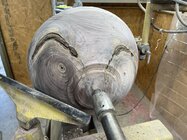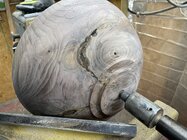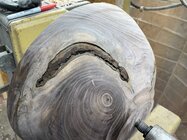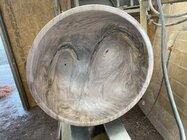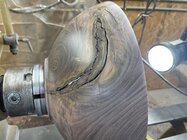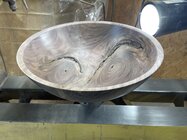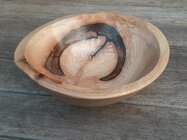Only you can decide if the piece is structurally ok to turn safely. You've already made that decision for a 1.5" thick bowl, but final turning requires more attention to detail. Touch, bang, wiggle, and listen to the bowl to enhance your evaluation. And stop as you turn it down to re-evaluate. Sounds like you have all this covered, but it is worth saying anyway.
Adding epoxy and/or pewa won't always make an unsafe piece safe - especially if significant cracks go thru the tenon or all the way to the rim. And trying to adhere epoxy to flaky bark is structurally sketchy.
You can do things like wrapping strapping tape (that package tape with strings in it) to for a bit of extra insurance.
Assuming it's safe, all the other choices are artistic and utilitarian (are you trying to make a bowl for soup or fruit or display).
Based on the pics, here's what I'd probably do:
Finish turn the outside and take the inside down some more (at least find round).
Dig out the soft stuff in the center of the piths.
Add big pewa across the inclusions and small ones across some of small cracks around the piths, and/or across the pith itself.
Fill inclusions, piths, and cracks from the outside with epoxy (I add a drop or 2 of India ink for black). Painters tape and hot glue dams. Several applications till it's all filled to the outer surface, sand it down and probably one final squeegee to fill pin holes.
Finish turn inside, and re-fill epoxy from the inside.
Finish the foot and address any re-filling there.
It's a lot of work, and a lot of waiting for epoxy to cure.
 .
. 